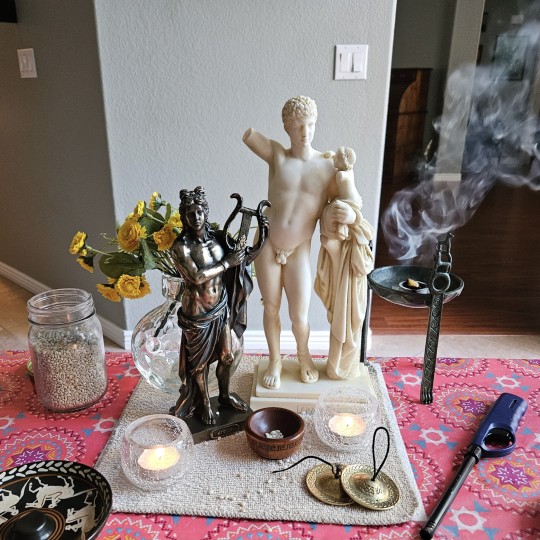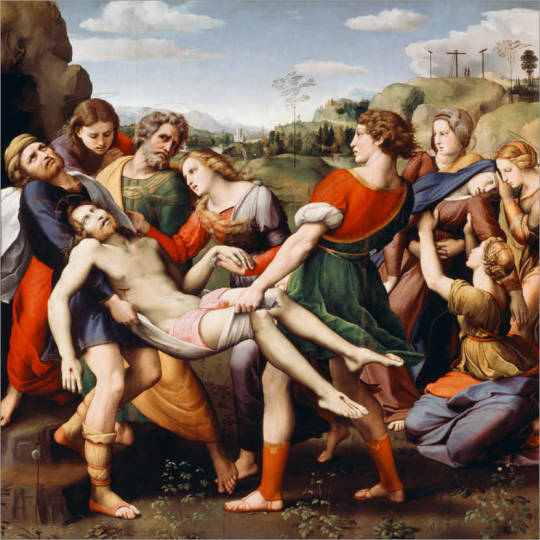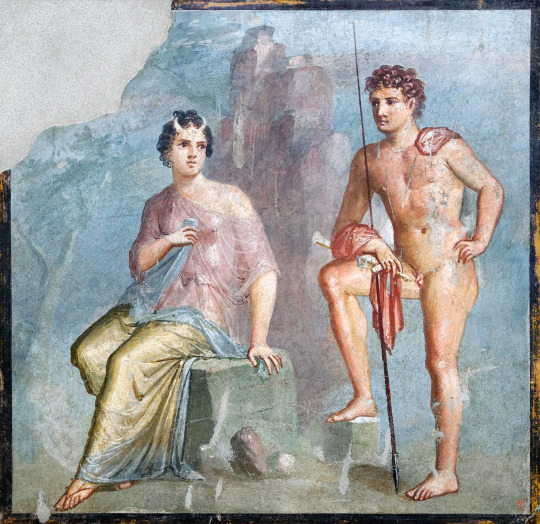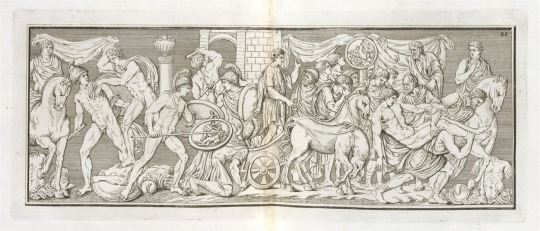#Meleagros’s
Text


Tending the dining room altar. :)
#Meleagros’s#Hermes#Hermes deity#Apollo#Apollo deity#The Mousai#The Muses#Greek gods#Greek god#Greek goddesses#Greek goddess#Hellenic polytheism#Hellenic polytheist#Hellenic paganism#Hellenic pagan#Hellenic reconstructionism#Hellenic reconstructionist#Hellenic revivalism#Hellenic revivalist#Helpol
400 notes
·
View notes
Text


Meleagros trans. Willis Barnstone
9 notes
·
View notes
Text

EPIGRAMA FUNERARIO
Aquí yace la verde caballeta
que Hele tierna cebó dos estaciones
y alas vibraba bajo pies serrados
en el codeso, el pino o el arándano.
Se calló ¡ay! la natural forminge,
musa de la besana y de las mieses.
Pisa ligero, amigo, y no la abrumes
no vayas a turbar su sueño leve.
Hela allí, blanca entre el tomillo espeso,
la piedra funeraria recién puesta:
¡cuántos hombres no alcanzan tal destino!
Riegan su tumba lágrimas de niña,
y la lustra con gotas de rocío
cada mañana la piadosa Aurora.
*
ÉPIGRAMME FUNÉRAIRE
Ici git, Étranger, la verte sauterelle
Que durant deux saisons nourrit la jeune Hellé,
Et dont l’aile vibrant sous le pied dentelé
Bruissait dans le pin, le cytise ou l’airelle.
Elle s’est tue, hélas ! la lyre naturelle,
La muse des guérets, des sillons et du blé ;
De peur que son léger sommeil ne soit troublé,
Ah ! passe vite, ami, ne pèse point sur elle.
C’est là. Blanche, au milieu d’une touffe de thym.
Sa pierre funéraire est fraîchement posée ;
Que d’hommes n’ont pas eu ce suprême destin !
Des larmes d’un enfant sa tombe est arrosée,
Et l’Aurore pieuse y fait chaque matin
Une libation de gouttes de rosée.
José-Maria de Heredia
di-versión©ochoislas
#José-Maria Heredia#literatura francesa#poesía parnasiana#epigrama#Meleagro#caballeta#muerte#piedad#di-versiones©ochoislas
2 notes
·
View notes
Text
¡Noooooooooo! ¡Meleagrooooooooooooos 😭! ¡Tan solo mató a sus tíos hinchapelotas! ¡Tampoco es tan grave! 😭😭😭😭 ¡Hubieran sido una pareja tan linda él y Atalanta... 😭😭😭 ¡Chingen a su madre Altea, las Moiras y Artemisa! 😭😭😭
#perdón es que recién lo escuché al mito y me enamoré de él porque él se enamoro de Atalanta#pinches moiras culeras#mitología griega#Atalanta#Meleagros#Altea#Moiras#Artemisa
2 notes
·
View notes
Text




2 notes
·
View notes
Photo

Cástor y Pólux
Cástor y Pólux, los Dioscuros, son figuras de las mitologías griega y romana, considerados como los hijos gemelos de Zeus o Júpiter. Son figuras semidivinas y se les atribuye el rol de salvar a los que están en peligro en el mar o en la guerra. Se asociaban especialmente con los caballos y los deportes. Estos hermanos tenían una conexión especial con Esparta, y tenían sus propios templos en Atenas y en Delos. Los dioscuros eran los patrones de los caballeros romanos y tenían un papel importante en las ceremonias marciales hasta la época imperial.
Leer más...
0 notes
Text
El cuarto oscuro (Memoria por castigo)
El cuarto oscuro (Memoria por castigo)

View On WordPress
1 note
·
View note
Text
[Amore greco][Filippomaria Pontani]
Un'antologia dedicata a temi e figure della poesia omosessuale nella Grecia classica ed ellenisitica: "Amore greco" a cura di Filippomaria Pontani
Da Saffo a Teognide, da Callimaco a Meleagro, questa antologia ripercorre temi e figure della poesia omosessuale fiorita nella Grecia classica ed ellenistica – una cultura nella quale il rapporto amoroso tra persone dello stesso sesso era consuetudine non solo tollerata ma entro certi limiti valorizzata – e ne documenta la persistenza nella lirica europea sino al Novecento attraverso continue,…

View On WordPress
#2022#amore#Amore greco#Callimaco#Filippomaria Pontani#Garzanti#Garzanti libri#Grecia#Italia#Kavafis#LGBT#LGBTQ#libri gay#Lord Byron#Meleagro#Michelangelo#Oscar Wilde#Pessoa#Pierre Louÿs#poesia#poesia gay#Poesie#Renée Vivien#Saffo#Teognide
0 notes
Text

Io wearing bovine horns watched over by Argos on Hera's orders, sala LXXII
Casa di Meleagro, Pompeii (VI, 9, 2.13, tablinum 8)
#fresco#greek mythology#pompeii#pompeii fresco#lo#argos#hera#art#european art#southern europe#mediterranean#cradle of civilization#mythology#mythological art#europa#western civilization#fine art#classical art#europe#european#fine arts
79 notes
·
View notes
Text
Te hablaba del jarrón azul de loza,
de un libro que me habían regalado,
de las Islas Niponas, de un ahorcado,
te hablaba, qué sé yo, de cualquier cosa.
Me hablabas de los pampas grass con plumas,
de un pueblo donde no quedaba gente,
de las vías cruzadas por un puente,
de la crueldad de los que matan pumas.
Te hablaba de una larga cabalgata,
de los baños de mar, de las alturas,
de alguna flor, de algunas escrituras,
de un ojo en un exvoto de hojalata.
Me hablabas de una fábrica de espejos,
de las calles más íntimas de Almagro,
de muertes, de la muerte de Meleagro.
No sé por qué nos íbamos tan lejos.
Temíamos caer violentamente
en el silencio como en un abismo
y nos mirábamos con laconismo
como armados guerreros frente a frente.
Y mientras proseguían los catálogos
de largas, toscas enumeraciones,
hablábamos con muchas perfecciones
no sé en qué aviesos, simultáneos diálogos.
Silvina Ocampo.
#poesía#poemas#poetas#acción poética#libros#books#escritos#frases#citas#notas#literatura#argentina#buenos aires#uruguay#poetry#amor#desamor#pensamientos#sentimientos#arte#silvina ocampo
22 notes
·
View notes
Note
Gods can be portrayed as darker skinned but they can't be portrayed as a different race without a single trace of Greek or Italian. bro there are people who draw them as black or islanders.
It's been a while since I've physically rolled my eyes at an ask, so thanks ig.
The ancient Greeks depicted their gods as being anthropomorphic, but it was never stipulated that they had to be Mediterranean-looking.
Zeus Aithiops (literally "the Black") was worshipped on the island of Chios during late antiquity (Lycophron, Cass. 537), and an instantiation of Artemis that was surnamed "Aithiopa" was worshipped elsewhere. Already, there is no reason why the gods can't be portrayed as Black. And need I remind you that Afro-Hellenes exist lmao??
IIRC, the Greek gods were also occasionally surnamed Aigyptios/Aigyptia, denoting them as being Egyptian. I know for certain that Dionysos and Artemis were viewed and portrayed as "foreign gods"; Jennifer Larson talks about their "foreignness" (both literal and metaphorical) at length in her book "Ancient Greek Cults: A Guide."
You're demonstrating a severe lack of faith in the agency of the gods, and making yourself out to be historically illiterate.
They are universal gods. The ancient Greeks were eager syncretists, often equating their gods with the divinities of other foreign populations to demonstrate their universality. If you have a problem with the gods being portrayed as not Greek, take it up with the ancient Greeks. There's also the fact that the gods aren't Greek in origin. Scholars maintain that the gods we know are Hellenic instantiations of preexisting gods that were imported from elsewhere. Herodotos even expresses a similar view in his Histories.
My brain is melting having to explain this to you.
#Meleagros answers (angrily)#Hellenic polytheism#Hellenic polytheist#polytheism#polytheist#Hellenic paganism#Hellenic pagan#paganism#pagan#paganblr#helpol#Hellenic reconstructionism#Hellenic reconstructionist#Hellenic revivalism#Hellenic revivalist#Greek gods#Greek goddess#Greek mythology#ancient Greek religion#ancient Greece
537 notes
·
View notes
Text
Le bionde trecce, gli occhi azzurri e poi...

Ieri un blog che seguo, postando questa foto del giocatore del Napoli e della Nazionale Giovanni Di Lorenzo, ha scritto che è un Apollo.
L'aggettivo che si rifà all'estetica del Dio Greco vale in italiano giovane di grande bellezza, per lo più in frasi (talora ironiche) come essere un a.; parere, credersi un a. (e, più spesso con la maiuscola, essere, sembrare un Apollo), con riferimento alle raffigurazioni scultoree o pittoriche del dio (voce Apollo, Vocabolario Treccani).
Tolta la dimensione ironica, assente in quel post, mi è venuto in mente che rispetto ad Apollo, Di Lorenzo ha i capelli di un altro colore. Sembrerà un particolare strano, ma la Mitologia Antica ha nella dimensione tricologica un aspetto niente affatto secondario.
Partiamo da una tradizione comune: Apollo, che era molto più che il dio del sole, aveva i capelli neri, con riflessi viola (oggi diremmo corvini). Il mito della sua nascita è meraviglioso: figlio di Zeus e della titanide Leto (o Latona), fu concepito nell'ennesima avventura extraconiugale del Re degli Dei (il tono è volutamente divertito); Era, come sempre furiosa delle avventure amorose del marito, venuta a sapere che Leto fosse incinta di Zeus, proibì alla partoriente di dare alla luce suo figlio su qualsiasi terra, fosse essa un continente o un'isola. Disperata, Leto vagò fino a giungere sull'isola di Delo, appena sorta dalle acque e, stando al mito, ancora galleggiante sulle onde e non ancorata al suolo. Essendo, perciò, Delo non ancora una vera isola, Leto poté darvi alla luce Apollo e la sua gemella Artemide, precisamente ai piedi del Monte Cinto. Secondo i miti, Artemide fu la prima dei gemelli a nascere, e aiutò la madre nel parto di Apollo. Questi nacque in una notte di plenilunio, che fu da allora il giorno del mese a lui consacrato: nel momento in cui nacque il dio, cigni sacri vennero a volare sopra l'isola, facendone sette volte il giro, poiché era il settimo giorno del mese. E appena nato, la testa del neonato fu poggiata su un cespuglio di violette, che trasferirono ai capelli del Dio quella sfumatura violetta, che gli sarà cara.
Il colore scuro dei capelli di Apollo era una rarità letteraria, poichè, per esempio, Omero descrive tutti gli dei con caratteristiche opposte: ci sono studi che descrivono come il rapporto tra divinità\eroi biondi e bruni sia 10 a 1, Afrodite è bionda, come pure Demetra. Atena è, per eccellenza, “l’occhicerulea Atena”. Il termine adoperato è glaukopis, che certo è in relazione anche con la civetta, sacra alla dea (glaux = civetta: occhi scintillanti, occhi di civetta), simbolo di saggezza. Oltre a ciò, altri leggendari eroi erano biondi: Menelao, Peleo, Achille e suo figlio Neottolemo, Meleagro, Radamanto, Clizio, Camerte. Si dice che persino Alessandro Magno fosse biondo.
Sappiamo con certezza dagli studi genetici sui resti nelle tombe che gli antichi greci e romani fossero molto più comunemente "di tipo mediterraneo", cioè pelle scura, occhi scuri, capelli scuri. Questa affermazione non vuol dire che non esistessero persone con i capelli biondi o gli occhi chiari, vuole dire che questi ultimi erano una minoranza genetica, almeno fino alla Roma Imperiale. Eppure l'essere biondi, essendo in minoranza, era considerato molto più affascinante. Pratica comune, tra le donne ricche, ma era pratica conturbante nei lupanari delle prostituite, era quella di colorare i capelli di biondo usando delle costosissime tinture allo zafferano o polveri colorate: le cronache del tempo ci dicono che richiedesse un grande sforzo per l'applicazione e avesse un odore ripugnante. Tra l'altro, la stessa parola biondo ha etimologia oscura: origine certa della parola è comunque l'antico francese blond (e il provenzale blon) da cui lo spagnolo blondo (poi sostituito nell'uso comune da rubio, dal latino rubeus, "rosso") e l'italiano biondo; i greci antichi per esempio usavano gli aggettivi xanthòs e xoutòs “biondo”, pyrrhòs “fulvo” e chrysoeidés “aureo”, riferiti ai capelli di uomini o Dei, aggettivi che corrispondono perfettamente al latino flavus, fulvus e auricomus; per descrivere le chiome lunghe e bionde usavano termini specifici come chrysokàrenos “testa bionda”, o chrysokóme “chioma d’oro”. E quest'eco rimane nella cultura occidentale, per esempio, nella ritrattistica medioevale e primo rinascimentale, dove è davvero difficile, se non in autoritratti, trovare una figura femminile simbolica che non sia bionda o dai capelli chiari.
Su questo fatto sono nate molte teorie: alcune sfiorano il razzismo, altre furono lo spunto per una certa storiografia mitteleuropea che vedeva già all'epoca greca antica caratteristiche dello spirito razionale dell'Europa centrale, dove si presume siano partiti per quelle terre i biondi (in pratica, una versione filo nazista della dicotomia nietzschiana apolinneo\dionisiaco), esistono inoltre decine di libri sull'origine "Indoeuropea" dei greci rispetto a quella levantina (che sarebbero i fenici, e le popolazioni del mediterraneo orientale).

Questa è L'Afrodite Cnidia: l'originale era opera di Prassitele, scolpita nel IV secolo a.C. Essendo perduta, rimangono alcune copie di età romana. È famosa non solo per la sua disarmante bellezza artistica, ma anche perché è il primo nudo femminile dell'arte greca e perché, secondo tutte le fonti, aveva i capelli biondi.
I poeti hanno amato e cantato per lo più donne pallide e dai capelli biondi; anzi fra tutti gli spietati imitatori del Petrarca, se non mai, certo difficilmente si ritrova chi abbia messo nello sbiadito lusso delle sestine, delle canzoni e dei sonetti a frasi bell'e fatte, una fanciulla che non avesse
… i capei d'oro alla Laura sparsi
Corrado Ricci (1858 – 1934), archeologo e storico dell'arte italiano
17 notes
·
View notes
Text

Deposition
1.
Aby Warburg kommt an dem Tag, an dem er den Dom von Orvieto und darin das Corporale des Blutwunders von Bolsena besucht, auch an der Stelle vorbei, an der die Leiche Matteottis deponiert wurde. Warburgs Staatstafeln protokollieren noch einmal etwas, was man mit einem polaren Muster Gründungsopfer/Gründungsmord nennen kann.
Warburg zeichnet zwar nur eine Seite auf, zeigt auf der Tafel mit dem Corporale nur jenen Teil des diplomatischen Protokolls, in dem ein gefaltetes, blutiges Tuch das Wunder bezeugt oder beweist. Er zeigt nur das Opfer, nicht den Mord und keinen Leichnam. Das muss er aber auch nicht, weil es ihm um Formeln geht, die auf spezifische Weise ambigue sind, nämlich durch ihre Polarisierung. Ihr andere Seite ist ihnen eingeschlagen oder involviert. Auch nur eine Seite zeigt schon 'nach innen' etwas anderes als 'nach außen', vor allem aber bleibt die Unterscheidung, was auf der Innenseite und auf der Außenseite eines Symboles liegt pendelnd. Man kann nicht sagen, dass die Unterscheidung zwischen Innenseite und Außenseite instabil bleibt, auch die Unterscheidung zwischen Stabilität und Instabilität pendelt durch eine Form, deren Bewegung nur durch das Distanzschaffen und die Symbole läuft.
Warburg signiert die Staatstafeln nicht, er verwandelt insoweit die Akten nicht in ein Buch, er schließt sein Protokoll nicht ab. Wenn man das amtliche Schreiben, das Warburg für das Kuratorium der K.B.W. formuliert hat, beim Wort nimmt und die Institution als Handbuch, zum Beispiel selbst wie einen Formularbuch, wie einen (Beamten-)Kalender nutzt, dann dienen die Staatstafeln 'nur' dazu, ein Protokoll anzulegen, das dann fortgeführt werden muss und vor allem nach Warburg auch in mindestens zwei Richtungen, also mit polarisierten Mustern weitergeführt werden muss. Nicht die Bedeutung der Ereignisse und ihrer Bilder, ihre Kehrbarkeit steht im Vordergrund.
2.
Die Bilder, die Warburg anlegt, werden nach Warburgs Tod ohnehin weitergeführt: Das Opfer wird weiter abgebildet, sogar Matteotti selbst wird später ins Bild genommen und die Bilder sind wieder als Effekte von Bildgebungen lesbar, deren Apparat auch aus Pathosformeln besteht. Das Kinoplakat der Verfilmung von 1973 (mit Franco Nero als Matteotti und Mario Adorf als Mussolini) greift mit dem horizontal in der Luft schwebenden Körper Matteottis Formeln der Grablegung auf - und zeigt auch die Polarität einer Formel, die ruhig/besonnen und orgiastisch einsetzbar ist. Aby Warburg hatte den Figuren der Grablegung auf eine antike Vorprägung bezogen, nämlich auf Bilder des toten Meleager: Die Beweinung eines toten Helden sei die Vorprägung der Bilder zur Beweinung des toten Christus. Das Filmplakat zeigt insofern den Rückschlag einer Formel in Tragische und Heroische, bei dem auchein Umschlag von Besonnenheit in Orgiasmus stattfindet.
Die in der Luft schwebenden Beine, die vom Boden sind oder denen der Boden genommen ist, sind schon für sich ambigue, ohne in der Form abweichen zu müssen, wenn so eine Gebärde zwischen Bildern der Grablegung Christi und denen der Entführung und Ermordung Matteottis pendelt. Das Gesicht Matteottis, der Schrei, die geballte Faust wird abgewandelt, aber der restliche Körper ist ohnehin so 'formuliert', dass die Form Umwidmungen ermöglicht, seien es Warburgs "Inversionen" oder das, was Foucault den "Dämon des Selben" nennt. Der Sinn ist in der Gebärde deponiert und depositioniert, die Musterung ist polarisiert. In dem Sinne ist die Gebärde auch 'sarkophag', sie ist fleischverzehrend, vage und verschlungen, aber in keinem Detail unpräzise.
Einer Mörder trägt ein Polobjekt in der Hand.

#il delitto matteotti#warburgs staatstafeln#deposition#deponierung#anonymer italienischer stecher#tod des meleagros
2 notes
·
View notes
Note
Kind of related to the ask on Cleopatra, and even your one way earlier on Krateros… What do you think Alexander would’ve been like if he weren’t an Argead, and instead fated to be a Marshal for whoever else was meant for the throne? Do you think he would’ve been rebellious? Or cutthroat and ambitious like Krateros? Or more-so disciplined and loyal? I kind of see him as a combination of all three because I don’t peg Alexander for someone who can be contained, lol.
To answer this, we must keep in mind that, for the ancient Greeks, belief in divine parentage for certain family lines was very real. A given family and/or person ruled due to their descent. The heroes in Homer had divine parents/grandparents/great-grandparents. This notion continued into the Archaic period with oligarchic city-states ruled by hoi aristoi: “the best men.” (Yes, our word “aristocrat” comes from that.) Many of these wealthy families claimed divine ancestry; that’s why they were “best.”
In the south, this began to break down from the 5th century into the 4th. But not in Macedonia, Thessaly, or Epiros. In fact, even by Alexander’s day, many Greek poleis remained oligarchies, not democracies. And in democracies, “equality” was reserved for a select group: adult free male citizens. Competition (agonía) was how to prove personal excellence (aretȇ), and thereby gain fame (timȇ) and glory (kléos). All this was still regarded as the favor of the gods.
Alexander believed himself destined for great things because he was raised to believe that, as a result of his birth. Pop history sometimes presents only Olympias as encouraging his “special” status. But Philip also inculcated in Alexander a belief he was unique. He (and Olympias) got Alexander an Epirote prince as a lesson-master, then Aristotle as a personal tutor. Philip made Alexander regent at 16 and general at 18. That’s serious “fast track.” Alexander didn’t earn these promotions in the usual way; he was literally born to them.
If Alexander hadn’t been an Argead, that would have impacted his sense of his place in the world no less than it did because he was an Argead. What he might have reasonably expected his life path to take would have depended heavily on what strata of society he was born into.
Were he a commoner, in the Macedonian military system, his ambitions might have peaked at decadarch/dekadarchos (leader of a file). Higher officer positions were reserved for aristocrats through Philip’s reign. With Alexander himself, after Gaugamela, things started to change for the infantry, at least below the highest levels (but not in the cavalry, as owning a horse itself was an elite marker). Under Philip, skilled infantry might be tagged for the Pezhetairoi (who became the Hypaspists under ATG). But Alexander himself wouldn’t have qualified because those slots weren’t just for the best infantrymen, but the LARGEST ones. (In infantry combat, being large in frame was a distinct advantage.) So as a commoner, Alexander’s options would have been severely limited.
Things would have got more interesting if he’d been born into the ranks of the Hetairoi families, especially if from the Upper Macedonian cantons.
Lower cantons were Macedonian way back. If born into those, he (and his parents) would have been jockeying for a position as syntrophos (companion) of a prince. Then, he’d try to impress that prince and gain a position as close to him as possible, which could result in becoming a taxiarch/taxiarchos or ilarch/ilarchos in the infantry or cavalry. But he’d better pick the RIGHT prince, as if his wound up failing to secure the kingship, he might die, or at least fall under heavy suspicion that could permanently curtain real advancement.
That was the usual expectation for Lower Macedonian elites. Place as a Hetairos of the king and, if proven worthy in combat, relatively high military command. Yes, like Krateros. But hot-headedness could curtail advancement, as apparently happened to Meleagros, who started out well but never advanced far. The higher one rose, the more one became a potential target: witness Philotas, and later Perdikkas. In contrast, Hephaistion was Teflon (until his death). Yet Hephaistion’s status rested entirely on his importance to Alexander. And he probably wasn’t Macedonian anyway; nor was Perdikkas from Lower Macedonia, for that matter.
The northern cantons were semi-independent to fully autonomous earlier in Macedonian history. Their rulers also wore the title “basileus” (king); we just tend to translate it as “prince” to acknowledge they became subservient to Pella/Aigai. Philip incorporated them early in his reign, and I think there’s a tendency to overlook lingering resentment (and rebellion) even in Philip’s latter years. Philip’s mother was from Lynkestis, and his first wife (Phila) from Elimeia. Those marriages (his father’s and his) were political, not love matches.
Similarly, Oretis was independent, and originally more connected to Epiros. Note that Perdikkas, son of Orontes, was commanding entire battalions when he, too, was comparatively young. Like Alexander, he was “born” to it. Carol King has a very interesting chapter on him in the upcoming collection I’m editing, one that makes several excellent points about how later Successors really did a number on Perdikkas’s reputation (and not just Ptolemy).
If Alexander had been born into one of these royal families from the upper cantons, quasi-rebellious attitudes might be more likely. Much would depend on how he wanted to position himself. Harpalos, Perdikkas, Leonnatos, Ptolemy…all were from upper or at least middle cantons. They faired well. For that matter, Parmenion himself may have been from an upper canton and decided to throw in his hat with Philip.
By Philip’s day, trying to be independent of Pella was not a wise political choice, but if one came from a royal family previously independent, we can see why that might be seductive. Lower Macedonia had always been the larger/stronger kingdom. But prior to Philip, Lynkestis and Elimeia both had histories of conflict with Macedonia, and of supporting alternate claimants for the Macedonian throne. At one point in (I think?) the Peloponnesian War, Elimeia was singled out as having the best cavalry in the north. Aiani, the main capital, had long ties WEST to Corinthian trade (and Epirote ports). It was a powerful kingdom in the Archaic/early Classical era, after which, it faded.
So, these places had proud histories. If Alexander had been born in Aiani, would he have been willing to submit to Philip’s heir? Maybe not. But realistically, could he have resisted? That’s more dubious. By then, Elimeia just didn’t have the resources in men and finances.
I hope this gives some insight into how much one’s social rank influenced how one learned to think about one’s self. Also, it gives some insight into political factions in Macedonia itself. As noted, I believe we fail to recognize just how much influence Philip had in uniting Lower and Upper Macedonia. Nor how resentment may have lingered for decades. I play with this in Dancing with the Lion: Rise, as I do think it had an impact on Philip’s assassination.
(Spoiler!)
Philips discussion with his son in the Rise, and his “counter-plot” (that goes awry) may be my own invention, but it’s based in what I believe were very real lingering resentments, 20+ years into Philip’s rule.
#asks#Alexander the Great#Alexander alternate history#ancient Macedonia#ancient Macedonian politics#Upper Macedonia#Lower Macedonia#Macedonian internal politics#Philip II of Macedon#ancient history#Classics
7 notes
·
View notes
Text
Te hablaba del jarrón azul de loza,
de un libro que me habían regalado,
de las Islas Niponas, de un ahorcado,
te hablaba, qué sé yo, de cualquier cosa.
Me hablabas de los pampas grass con plumas,
de un pueblo donde no quedaba gente,
de las vías cruzadas por un puente,
de la crueldad de los que matan pumas.
Te hablaba de una larga cabalgata,
de los baños de mar, de las alturas,
de alguna flor, de algunas escrituras,
de un ojo en un exvoto de hojalata.
Me hablabas de una fábrica de espejos,
de las calles más íntimas de Almagro,
de muertes, de la muerte de Meleagro.
No sé por qué nos íbamos tan lejos.
Temíamos caer violentamente
en el silencio como en un abismo
y nos mirábamos con laconismo
como armados guerreros frente a frente.
Y mientras proseguían los catálogos
de largas, toscas enumeraciones,
hablábamos con muchas perfecciones
no sé en qué aviesos, simultáneos diálogos
23 notes
·
View notes
